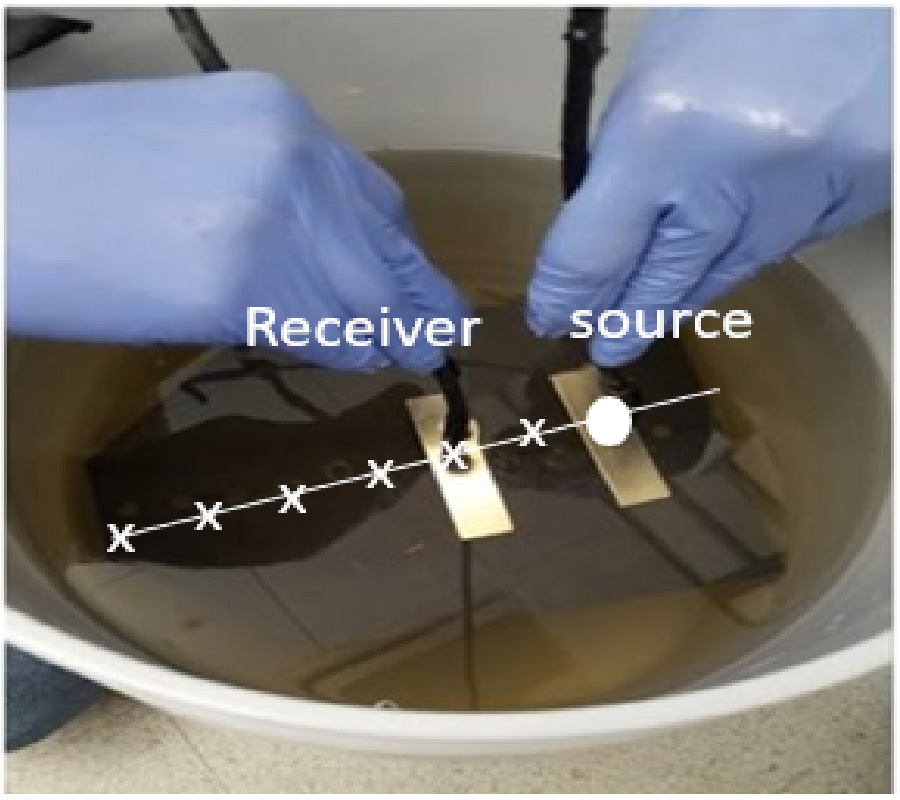Vol. 104
Latest Volume
All Volumes
PIERC 150 [2024]
PIERC 149 [2024]
PIERC 148 [2024]
PIERC 147 [2024]
PIERC 146 [2024]
PIERC 145 [2024]
PIERC 144 [2024]
PIERC 143 [2024]
PIERC 142 [2024]
PIERC 141 [2024]
PIERC 140 [2024]
PIERC 139 [2024]
PIERC 138 [2023]
PIERC 137 [2023]
PIERC 136 [2023]
PIERC 135 [2023]
PIERC 134 [2023]
PIERC 133 [2023]
PIERC 132 [2023]
PIERC 131 [2023]
PIERC 130 [2023]
PIERC 129 [2023]
PIERC 128 [2023]
PIERC 127 [2022]
PIERC 126 [2022]
PIERC 125 [2022]
PIERC 124 [2022]
PIERC 123 [2022]
PIERC 122 [2022]
PIERC 121 [2022]
PIERC 120 [2022]
PIERC 119 [2022]
PIERC 118 [2022]
PIERC 117 [2021]
PIERC 116 [2021]
PIERC 115 [2021]
PIERC 114 [2021]
PIERC 113 [2021]
PIERC 112 [2021]
PIERC 111 [2021]
PIERC 110 [2021]
PIERC 109 [2021]
PIERC 108 [2021]
PIERC 107 [2021]
PIERC 106 [2020]
PIERC 105 [2020]
PIERC 104 [2020]
PIERC 103 [2020]
PIERC 102 [2020]
PIERC 101 [2020]
PIERC 100 [2020]
PIERC 99 [2020]
PIERC 98 [2020]
PIERC 97 [2019]
PIERC 96 [2019]
PIERC 95 [2019]
PIERC 94 [2019]
PIERC 93 [2019]
PIERC 92 [2019]
PIERC 91 [2019]
PIERC 90 [2019]
PIERC 89 [2019]
PIERC 88 [2018]
PIERC 87 [2018]
PIERC 86 [2018]
PIERC 85 [2018]
PIERC 84 [2018]
PIERC 83 [2018]
PIERC 82 [2018]
PIERC 81 [2018]
PIERC 80 [2018]
PIERC 79 [2017]
PIERC 78 [2017]
PIERC 77 [2017]
PIERC 76 [2017]
PIERC 75 [2017]
PIERC 74 [2017]
PIERC 73 [2017]
PIERC 72 [2017]
PIERC 71 [2017]
PIERC 70 [2016]
PIERC 69 [2016]
PIERC 68 [2016]
PIERC 67 [2016]
PIERC 66 [2016]
PIERC 65 [2016]
PIERC 64 [2016]
PIERC 63 [2016]
PIERC 62 [2016]
PIERC 61 [2016]
PIERC 60 [2015]
PIERC 59 [2015]
PIERC 58 [2015]
PIERC 57 [2015]
PIERC 56 [2015]
PIERC 55 [2014]
PIERC 54 [2014]
PIERC 53 [2014]
PIERC 52 [2014]
PIERC 51 [2014]
PIERC 50 [2014]
PIERC 49 [2014]
PIERC 48 [2014]
PIERC 47 [2014]
PIERC 46 [2014]
PIERC 45 [2013]
PIERC 44 [2013]
PIERC 43 [2013]
PIERC 42 [2013]
PIERC 41 [2013]
PIERC 40 [2013]
PIERC 39 [2013]
PIERC 38 [2013]
PIERC 37 [2013]
PIERC 36 [2013]
PIERC 35 [2013]
PIERC 34 [2013]
PIERC 33 [2012]
PIERC 32 [2012]
PIERC 31 [2012]
PIERC 30 [2012]
PIERC 29 [2012]
PIERC 28 [2012]
PIERC 27 [2012]
PIERC 26 [2012]
PIERC 25 [2012]
PIERC 24 [2011]
PIERC 23 [2011]
PIERC 22 [2011]
PIERC 21 [2011]
PIERC 20 [2011]
PIERC 19 [2011]
PIERC 18 [2011]
PIERC 17 [2010]
PIERC 16 [2010]
PIERC 15 [2010]
PIERC 14 [2010]
PIERC 13 [2010]
PIERC 12 [2010]
PIERC 11 [2009]
PIERC 10 [2009]
PIERC 9 [2009]
PIERC 8 [2009]
PIERC 7 [2009]
PIERC 6 [2009]
PIERC 5 [2008]
PIERC 4 [2008]
PIERC 3 [2008]
PIERC 2 [2008]
PIERC 1 [2008]
All Journals
Capacity and Efficiency Improvement of MIMO Antenna Systems for 5G Handheld Terminals
Ahmad Hamdi Abdelgwad
and
Mohammod Ali
The efficacy of including a defected ground structure (DGS) for mobile communication on a mobile phone PCB in improving the multiple input multiple output (MIMO) system performance is evaluated and demonstrated in the context of single and multiple-element two-port planar inverted-F antennas (PIFAs). The proposed scheme designed and developed for operation in the 3.5 GHz long term evolution (LTE) and future 5G frequency bands demonstrates efficiency improvement by 15% and capacity improvement by around 7% because of the significant reduction in mutual coupling between the antenna ports. Results in free space as well as next to a human head and hand phantom are presented.

High Quality Factor Microwave Multichannel Filter Based on Multi-Defectives Resonators Inserted in Periodic Star Waveguides Structure
Youssef Ben-Ali
,
Ilyass El Kadmiri
,
Zakaria Tahri
and
Driss Bria
The transmission spectrum of electromagnetic waves through a one-dimensional photonic star waveguides (SWGs) structure is obtained using the Green function method (GFM). The proposed structure is composed of a finite number of periodic cells; each cell contains a segment of length d1 grafted in its extremity by resonators of length d2. This periodic system is altercated by insertion of defects resonators located in three different sites, which have lengths d02, d04, and d06 different from that of the perfect resonators. The properties of such a multi-defects structure are suitable for tunable very narrow band multichannel filter applications in microwave domain. The perfect photonic structure demonstrates large microwave photonic band gaps (PBGs) in which the propagation of electromagnetic waves is prohibited. For the sake of comparison, we first introduce single defect resonators located in one site; this defect creates hence two transmission peaks (defect modes) in the gaps. These induced modes of noticeable transmissions and good quality factors permit our proposed SWGs to behave like a single narrow band channel filter. Several localized modes appear in the band gaps whenweintroduce three resonators defects of different lengths and located in three different sites. With an appropriate choice of the geometrical parameters d1 = 1 m,d2 = 0.5 m, d02 = d04=d06 = 2 m, our thrice defectives system can create, in the microwave frequencies range, till eight transmission peaks in the gaps when the defects are located in three consecutive sites.These peaks have very high values of transmission rates and important quality factors reaching Q=610000. Therefore, our proposed system acts as very narrow band multichannel filters for which defects modes shift towards the low frequencies when the defects resonators lengths increase. The results obtained demonstrate the dependence of the defect modes frequencies, transmission coefficient, and the quality factor on the resonators defects lengths, their numbers, and their positions inside the defective structure.
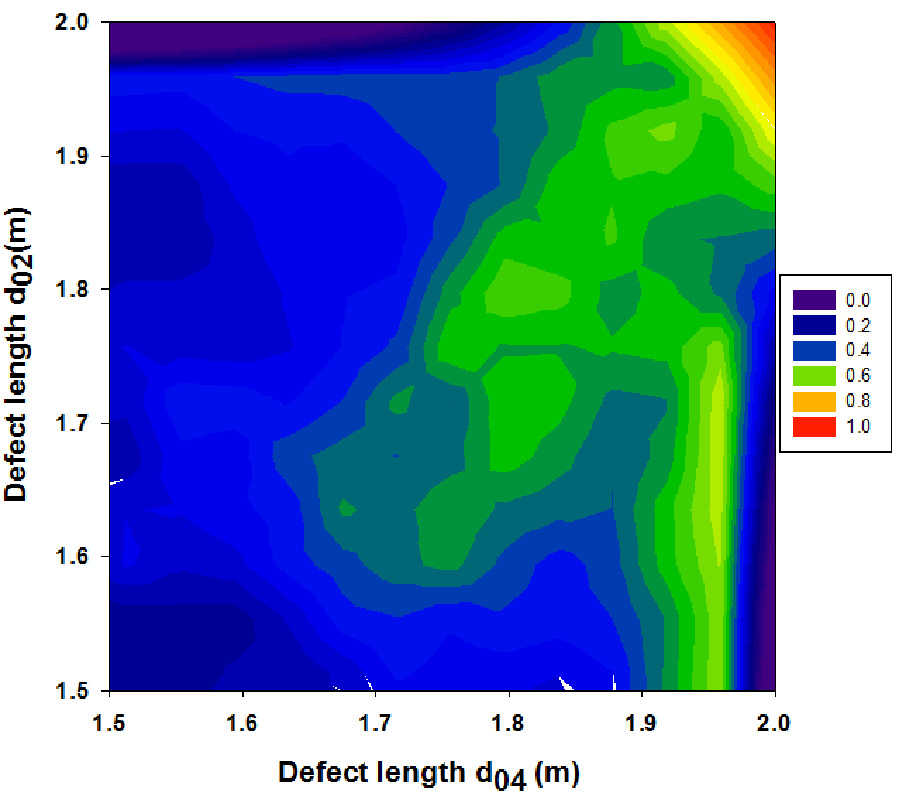
Design and Implementation of a Very Compact MIMO Antenna Providing Dual Notches at WLAN and Xband
Guvvala Ramya Sri
,
Areti Jhansi Rani
and
Vanka Saritha
A very compact Multiple-Input-Multiple-Output (MIMO) radiator providing dual notches is presented in this paper. It comprises circular ring monopoles fed by a microstrip line embedded with a slot of inverted U-shape. By etching a crescent slot, a split ring resonator slot, a circular slot in the circular monopole, a reversed U-shaped slot inserted along the feeding line, two notches are attained. It operates from 3.5 GHz to 12 GHz that overcomes interference from the Wireless Local Area Network(WLAN) (5.15-5.85 GHz) and X-band (7-8.1 GHz). MIMO antenna has a very compacted dimension of x 44 mm x 1.6 mm at the lowest operating frequency and hence is suitable for portable devices. It has dimensions of 0.51λ x 0.51λ x 0.018λ where λ is the wavelength of the lowest operating frequency 3.5 GHz.
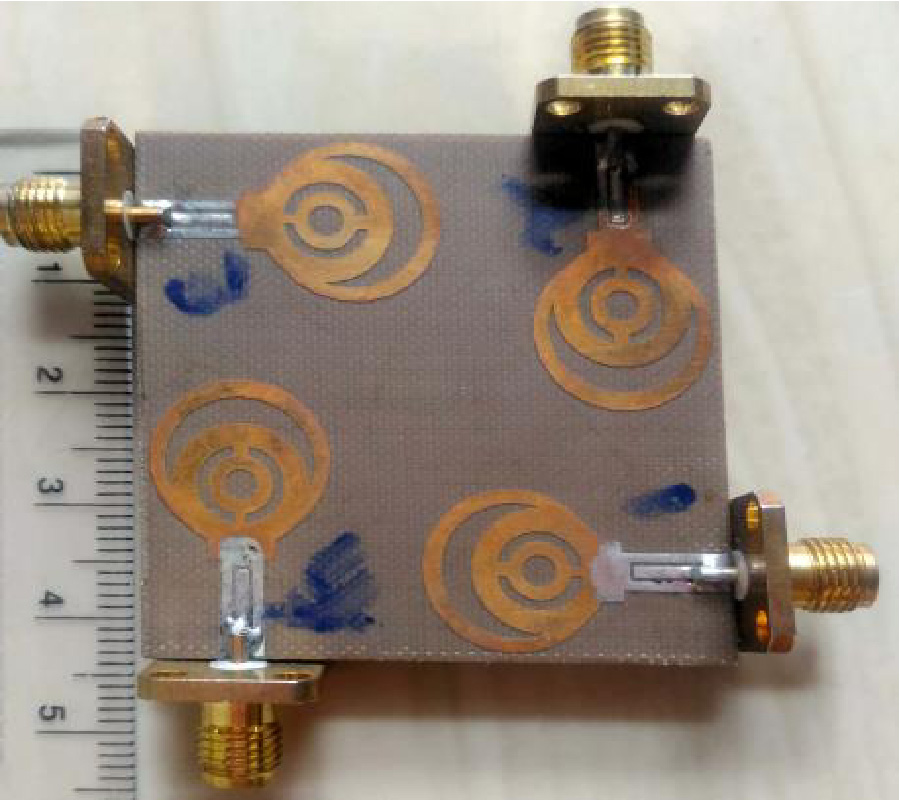
Wideband 10-Port MIMO Antenna Array for 5G Metal-Frame Smartphone Applications
Peng Liu
,
Yufa Sun
,
Tao Liu
,
Qing Li
and
Xuefeng Wang
A wideband 10-port multiple input multiple output (MIMO) antenna array operated below 6 GHz for the fifth generation (5G) metal-frame smartphones is presented and discussed in this paper. The proposed MIMO antenna array element is composed of a microstrip line with a tuning stub and rectangular slot. The size of the rectangular slot is only 15 mm x 2 mm (0.211λ0 x 0.028λ0, and λ0 is the wavelength with the resonance frequency of 4.2 GHz). U-shaped slots on the substrate are used to reduce the mutual coupling between the antenna elements. At the same time, in order to improve the radiation characteristics of the antenna arrays, narrow slits are etched in the metal-frame. The proposed antenna covers 3.3-5.5 GHz (S11 < -6 dB), which is ultra-wide bandwidth for the 5G communications. The proposed MIMO antenna array is fabricated and measured. Results show that in the desired wide frequency band, the proposed antenna array can achieve desirable performances, including antenna isolation better than -13 dB with decoupling structures, efficiency, and envelope correlation coefficient (ECC)<0.06. Moreover, radiation pattern, calculated ergodic channel capacity, the effects of the user's hand effects and head specific absorption rate (SAR) are also given in the paper. Good agreement between measured and simulated results is obtained, which means that the proposed MIMO array is a good candidate for 5G metal-frame smartphone applications.
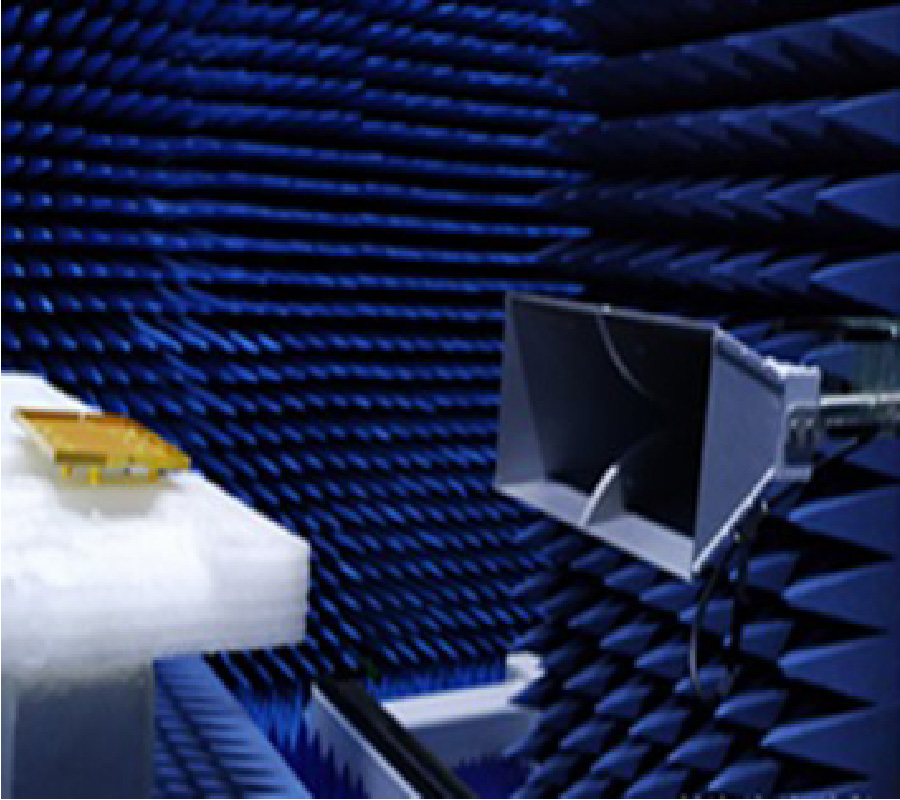
Sub-Domain Analysis of Asymmetrical Magnetic Field in Electrical Machines
Sohrab Amini Velashani
and
Jawad Faiz
Beside magnetic equivalent circuit and finite element methods, sub-domain analysis (SDA) is an alternative method, which can be used to evaluate electrical machines behavior. It has a reasonable accuracy, and its parametric nature is allowed to apply to optimization or sensitivity analysis. Commonly this method is based on variables separation technique of Maxwell equations and Fourier series, eigenvalues and eigen-functions are so important for obtaining accurate results. In this paper, Maxwell equations are solved for two adjacent regions, i.e., copper (Cu) and permanent magnet (PM). It was paid less attention before, and it introduces supplementary eigenvalue and eigen function for asymmetry conditions in Cu or PM magnetic field regions.
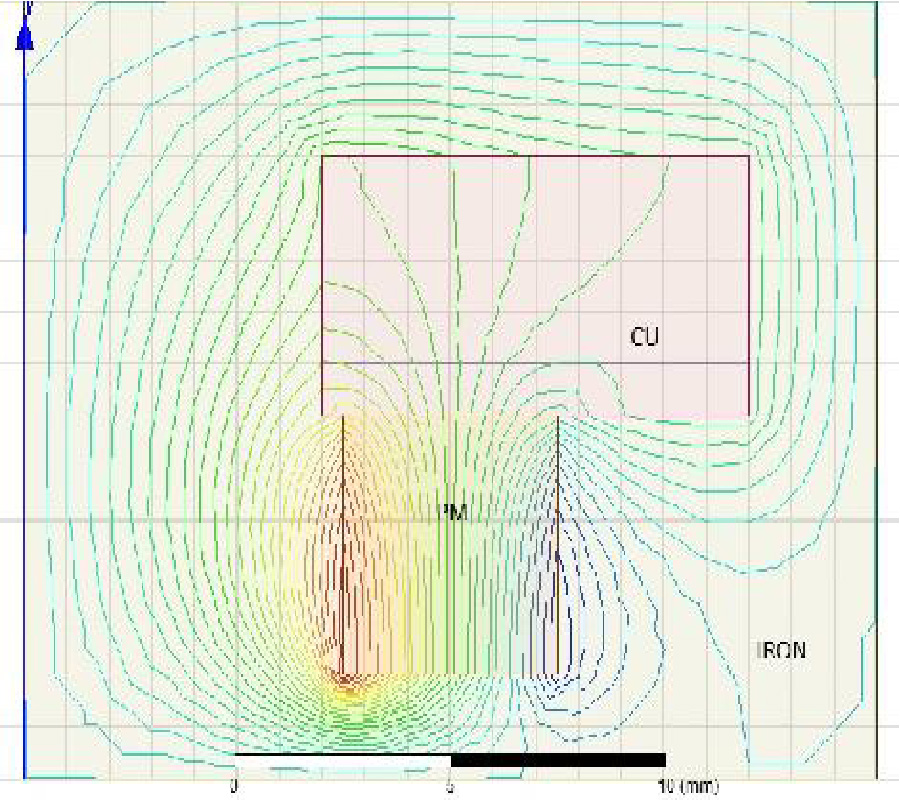
A Switchable Triple-Band Notched UWB Antenna Using Compact Multi-via Electromagnetic Band Gap Structure
Vijay Ramesh Kapure
,
Pramod P. Bhavarthe
and
Surendra S. Rathod
In this paper, a miniaturized triple-band gap multi-via electromagnetic band gap (TBMV-EBG) structure is proposed. Lumped LC modelling method is used for the analysis of the proposed TBMV-EBG structure. Triple band gaps in both x and y-directions are obtained since TBMV-EBG unit cell consists of three resonance parallel LC circuits. Ansys (HFSS) simulation is used in eigen mode to simulate a unit cell of the proposed EBG. There is a strong agreement between simulated and experimental results. Comparing the proposed TBMV-EBG with triple band slotted EBG, triple band CSRR-EBG, fractal EBG, and dual band split EBG, size reductions of 6.52%, 7.53%, 23.21%, and 25.86% are obtained respectively which is validated by simulated and experimental results. Demonstration of the proposed TBMV-EBG structure for ultra-wideband (UWB) application is also presented. Simulation and measurement results prove that by using a single TBMV-EBG cell at the feed line of a UWB monopole antenna triple band-notches can be obtained. Moreover, switching characteristics of the proposed antenna are also demonstrated using single P-I-N diode. Depending on the ON and OFF switching status of P-I-N diode, the UWB antenna provides switching from triple band-notches to dual band-notches, respectively. The proposed switchable monopole UWB antenna as a single unit can be useful in applications wherein switching between multi-bands is desirable without changing the geometry of the structure.
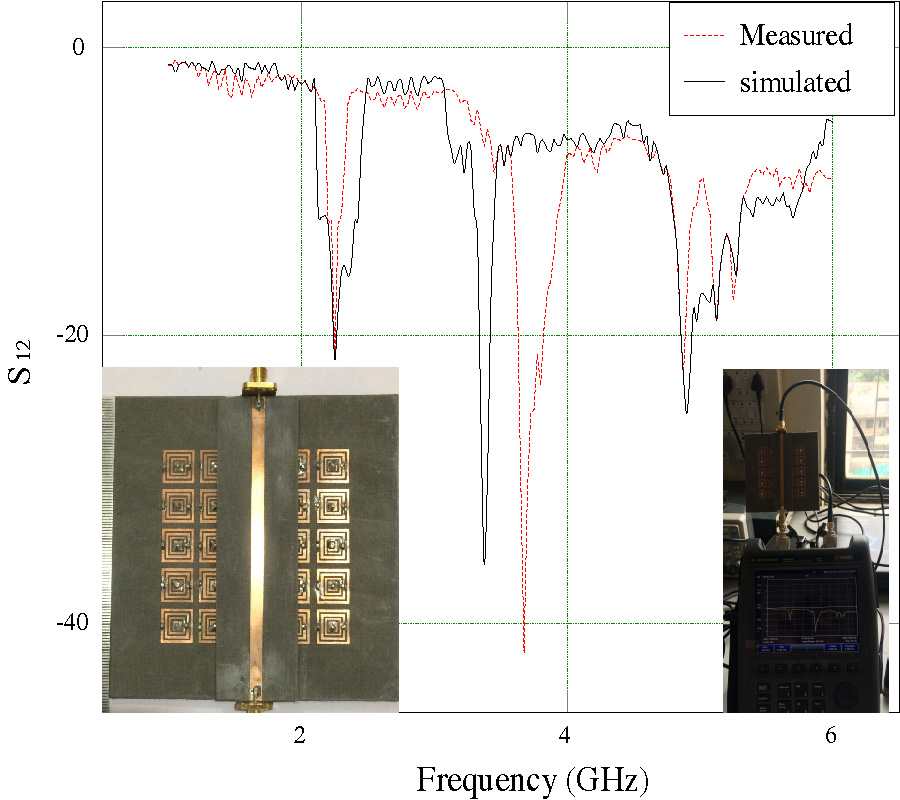
Free Vibration of Magnetic Gear with Intersecting Axes
Xiuhong Hao
,
Wenbin Hao
,
Qingkan Wang
and
Deng Pan
The dynamic performance optimization of magnetic gear devices is essential to their industrialization. In this study, upon considering the magnetic field coupling characteristics of different components of a field modulated magnetic gear with intersecting axes (FMMGIA), we first obtained the magnetic coupling stiffnesses of these components via the finite element method. On this basis, we further established a dynamic model as well as the corresponding differential equations for the magnetic gear. Thereafter, we analyzed the modal characteristics and the influences of the primary design parameters on the modal frequency of the FMMGIA system. The results indicated that the magnetic coupling stiffnesses among the FMMGIA components were significantly lower than the meshing stiffnesses of the mechanical gears. In addition, the magnetic gear system consisted of three orders of torsional modals as well as three orders of horizontal vibration modals, among which the torsional modal frequencies of both the input and output rotors were substantially lower than others. Finally, parameters such as the minimum axial length and the permanent magnet remanence demonstrated considerable have impacts on the modal frequencies of the FMMGIA system.
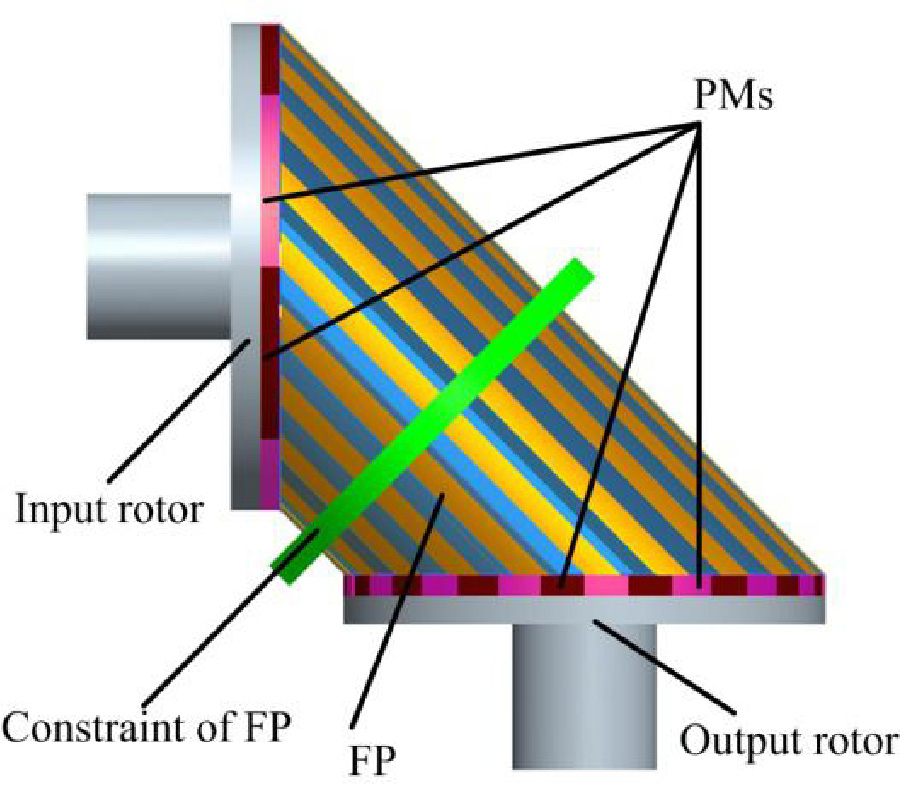
Friction-Free Permanent Magnet Bearings for Rotating Shafts: a Comprehensive Review
Siddappa Iranna Bekinal
and
Mrityunjay Doddamani
This article presents a comprehensive review of modeling,analysis,and development of permanent magnet bearings (PMB) for rotating shafts. The different configurations of PMB are highlighted with relevant approaches to estimate their features. The progress in mathematical approaches adopted and optimization of the static and dynamic bearing characteristics in terms of accuracy are discussed in depth. Further, key developments on instability issues and their realization in combination with other bearings for rotors stability in low and high-speed applications are reviewed. Finally, concluding remarks on key aspects to be followed in the design and development of PMB are presented.
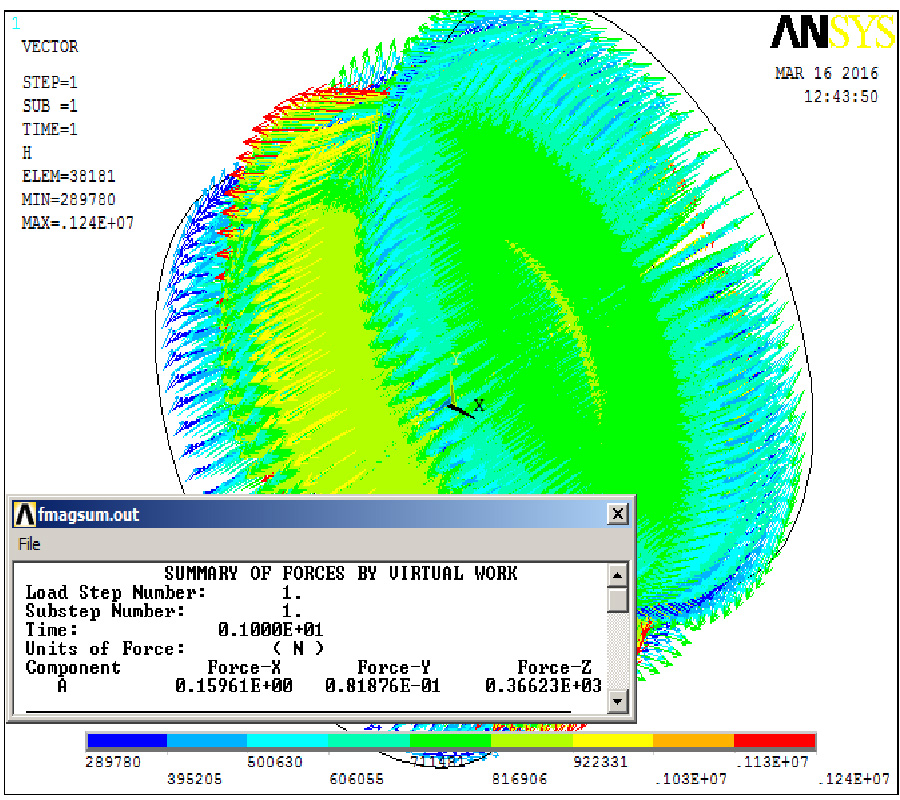
Stress Monitoring of Prestressed Steel Strand Based on Magnetoelastic Effect Under Weak Magnetic Field Considering Material Strain
Lei Liu
,
Senhua Zhang
,
Yinghao Qu
,
Jianting Zhou
,
Feixiong Yang
,
Rong Liu
and
Leng Liao
Prestressed steel strands are critical components of prestressed structures, which determine the bearing capacity of the structures. The prestress loss of steel strands causes the bearing capacity to decline. To monitor the stress of prestressed steel strands, a stress monitoring method based on the magnetoelastic effect was proposed. The influence of the material strain was considered to improve monitoring accuracy. To do the monitoring, a coil-based sensor, using a small excitation current to generate a necessary magnetic field, was employed. The sensor converted the stress into inductance. An experimental system was set up and two batches of specimens were tested. The experimental results showed that the measured inductance was stable and repeatable. There was a nonlinear relationship between the inductance and the stress. Strands of different batches need to be calibrated separately to obtain the inductance-stress equation. Based on the calibration equation and the measured inductance, the stress of strands could be calculated. The difference between the calculated stress and the actual stress was small. Besides, to improve the accuracy and ease of the construction, the self-induction coil of the senor should be one layer and with moderate turns.

A Study of an Inversion Model for Sea Ice Thickness Retrieval Using Simulated Annealing
Yu Jen Lee
,
Kee Choon Yeong
and
Hong-Tat Ewe
Previously, an inverse microwave scattering model based on radiative transfer was developed for the retrieval of sea ice thickness using radar backscatter data. The model, called the Radiative Transfer Inverse Scattering Model (RTISM), is a combination of the Radiative Transfer-Dense Medium Phase and Amplitude Correction Theory (RT-DMPACT) forward model and the Levenberg-Marquardt Algorithm (LMA). In this paper, the LMA in the RTISM is replaced with Simulated Annealing (SA) as the optimizer to allow a wider range of inversion capability. SA is a global optimizer, and its settings make it convenient to switch between different target parameters to be optimized for inversion. In this study, the model will first be tested using different data sets to verify its applicability. Next, the model is used to estimate the sea ice thickness around Ross Island, Antarctica using data from ground truth measurements together with satellite data from Radarsat-1 from the year 2006. In order to further validate the model, the data collected from measurements performed during an experiment to grow an ice sheet within a refrigerated facility at the U.S. Army Cold Regions Research and Engineering Laboratory (CRREL) are used to perform the retrieval of saline ice thickness. Preliminary results show that the new model performs as expected and shows potential. However, there are still limitations to the inverse model, and further improvements in the future need to be considered.
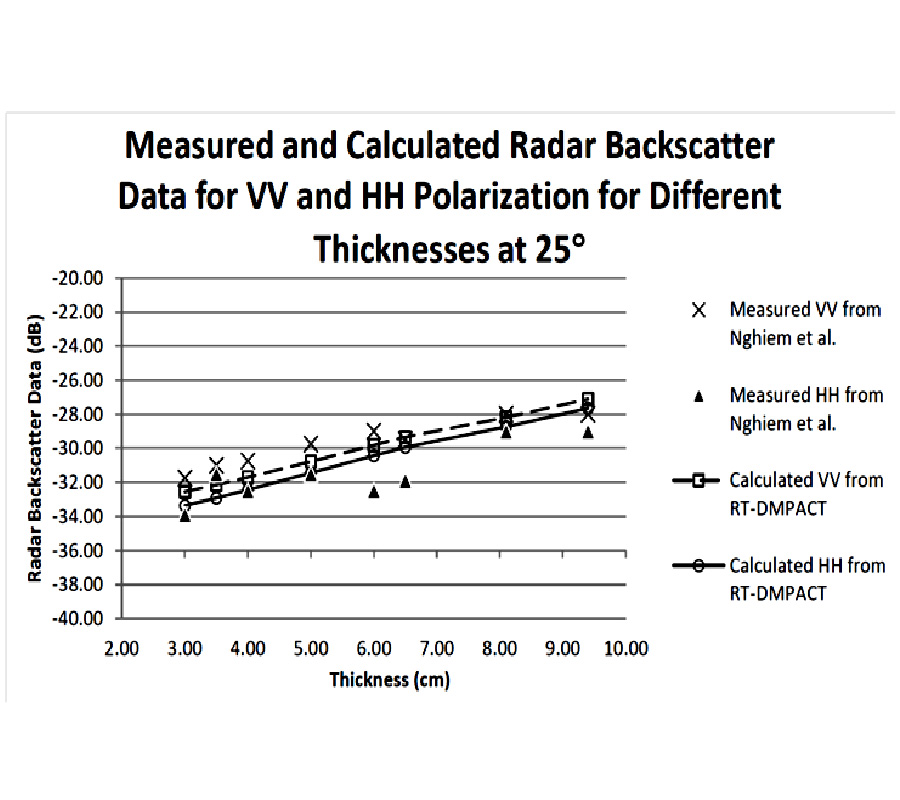
Half U-Slot and Rectangular Slot Loaded Nearly Square Microstrip Antennas for Wideband Response
Venkata A. P. Chavali
and
Amit A. Deshmukh
Wideband designs of nearly square microstrip antenna using two half U-slots and rectangular slots are proposed. The slots optimize the spacing in between the patch modified TM11, TM20, TM02, and TM30 resonant modes, to yield wideband response. The design with two half U-slots yields bandwidth of around 1000 MHz (~50%) whereas that with an additional rectangular slot yields bandwidth of 1345 MHz (~61%). Due to the presence of higher order modes, the proposed design offers higher cross polar radiation pattern across the entire bandwidth with the gain greater than 5 dBi. The formulations for the modified patch modes and subsequent redesign procedure are presented, which serve as a guideline in the designing of similar antennas around specific resonance frequency. With the given antenna characteristics, the proposed antennas will find applications in personal and mobile communication systems.
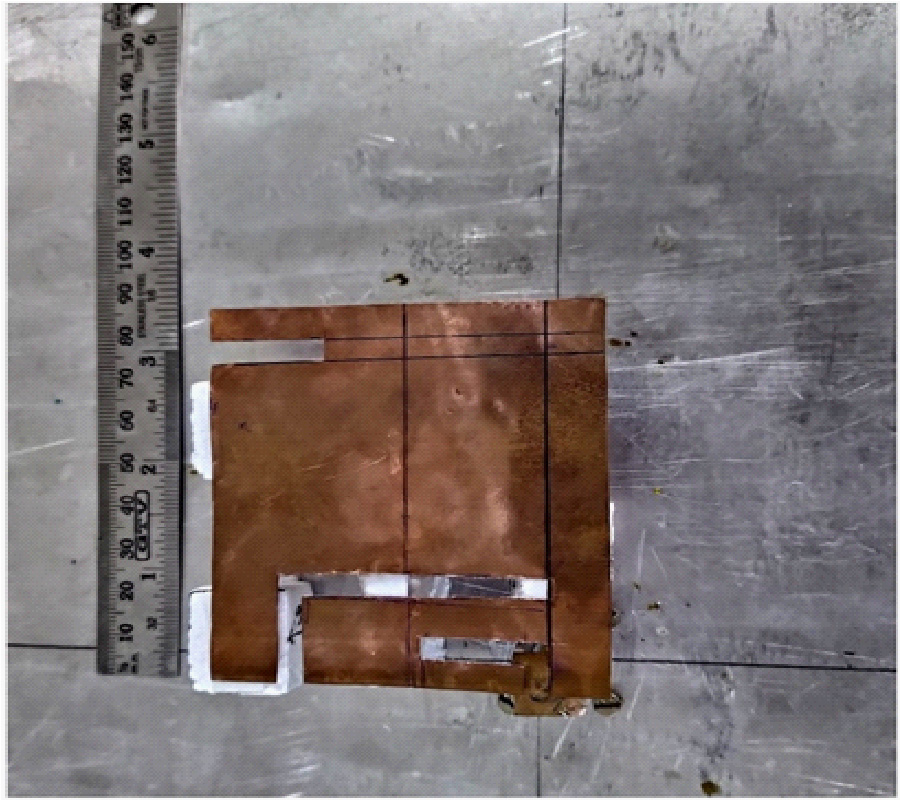
Analysis and Design of Two-Slot Antennas for Wireless Communication Applications
Khalil Sayidmarie
and
Karam Mudhafar Younus
This paper presents the design and investigation of array antennas formed of two narrow rectangular slots. Two approaches for feeding the two slots by microstrip lines are investigated as well as the influence of changing the distance between the slots on the radiation pattern. The two slots are etched on one side of the substrate, while the feed network is placed on the other side. Two designs, depending on the feeding approach, are presented. In the first design, a simple T-shaped divider is used to feed the two slots, while the second design is based on a single microstrip line which feeds the two slots in series. Two antennas are for the first design, each with dimensions of 57.83 х 41.3 mm2, while those of the second design have dimensions of 83.45 x 36.9 mm2. The four proposed designs have been simulated and optimized using Computer Simulation Technology (CST-MWS) simulation program. Prototypes were fabricated and tested to verify the designs. The four antennas achieved -10 dB impedance bandwidths between 8.6% and 9.4%, while the gain values were between 4.7 dB and 5.7 dB. The comparisons between the fabricated and simulated antennas considered the reflection coefficient and radiation pattern showing good agreement.
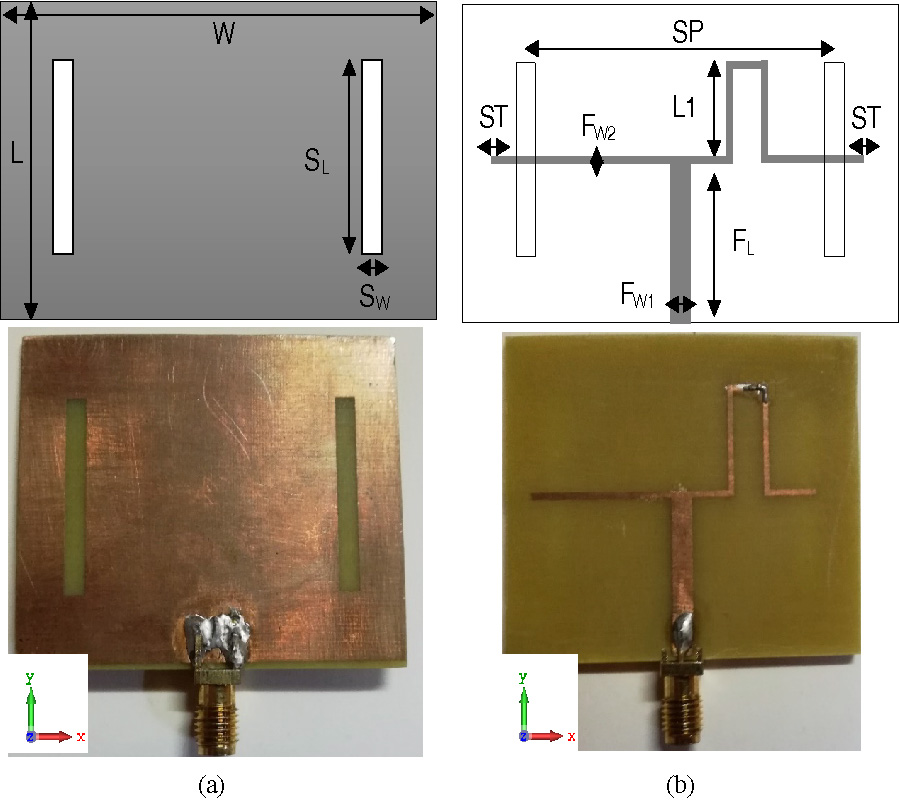
Reduction of Cogging Torque and Improvement of Electrical Parameters in Axial Flux Permanent Magnet (AFPM) Synchronous Generator with Experimental Verification
Engin Hüner
and
Gökhan Zeka
This paper presents an axial flux permanent magnet (AFPM) synchronous generator that was manufactured for the reduction of cogging torque by considering the different angles of a rectangle-shaped permanent magnet (RSPM). The placement angle of RSPM was changed from 0 to 28 degrees to obtain total harmonic distortion, line voltage, and cogging torque. A numerical finite element model using Maxwell software was created. The model was validated by the experimental results, with and without a load. The optimum placement angle was obtained at 20 degrees, whose total harmonic distortion (Thd) and cogging torque (Tc) were improved by 41.6% and 71.4%, respectively.
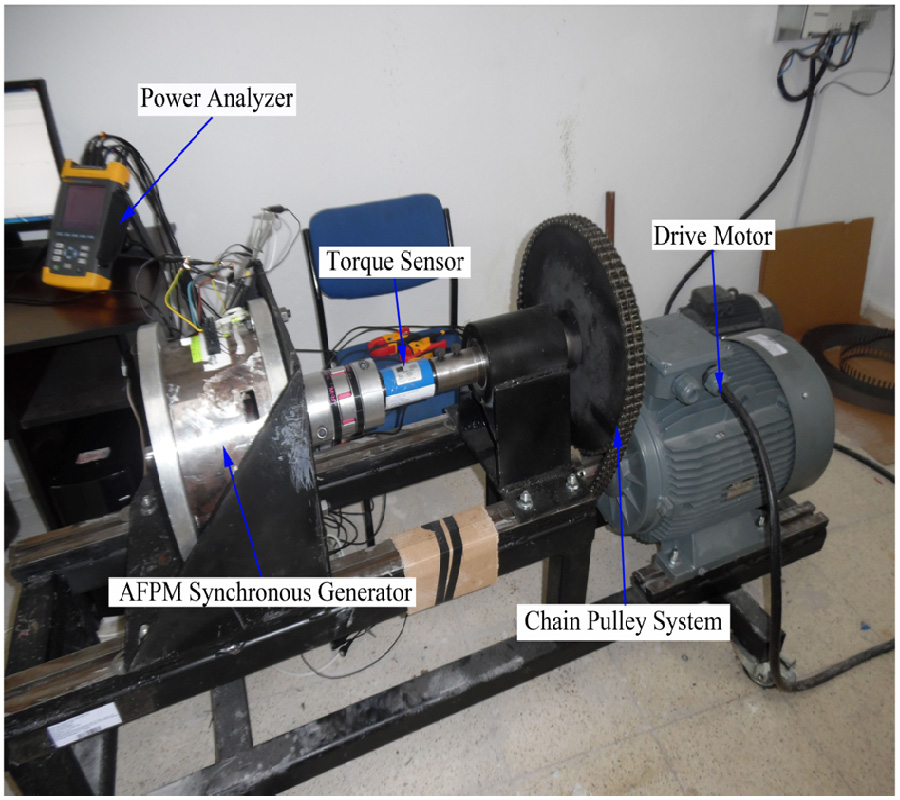
Impact of Users' Finger on the Amount and Direction of Radiated Power from a 28 GHz
4-Element MIMO Antenna Mobile Terminal
Ahmed Mohamed Elshirkasi
,
Azremi Abdullah Al-Hadi
,
Ping Jack Soh
,
Mohd Fais Mansor
,
Rizwan Khan
and
Prayoot Akkaraekthalin
This paper investigates the effect of index finger position and distance on the radiated power of 4-element MIMO antenna, operating at 28 GHz. The antenna elements (AEs) are located at the top corner of the user terminal and separated at a distance of half a wavelength. Four different finger placements were investigated, one placement over each AE with six interaction distances between the AEs and the finger at each position starting from 0 up to 2.5 mm. When the finger is placed on an edge AE, the other edge AE maintained above 85 % of its free space radiated power irrespective of the interaction distance. However, the radiated power of each AE was severely affected when the finger was placed on it or on the AE adjacent to it. This effect ranged from total blockage at direct interaction with the element (with a distance of 0 mm) to maintaining more than around 60 % of free space radiated power after the interaction distance is increased to more than 2.0 mm. Besides the effects of the index finger on the amount of radiated power, this work also investigated the direction of radiated power resulting from the influence of this finger.
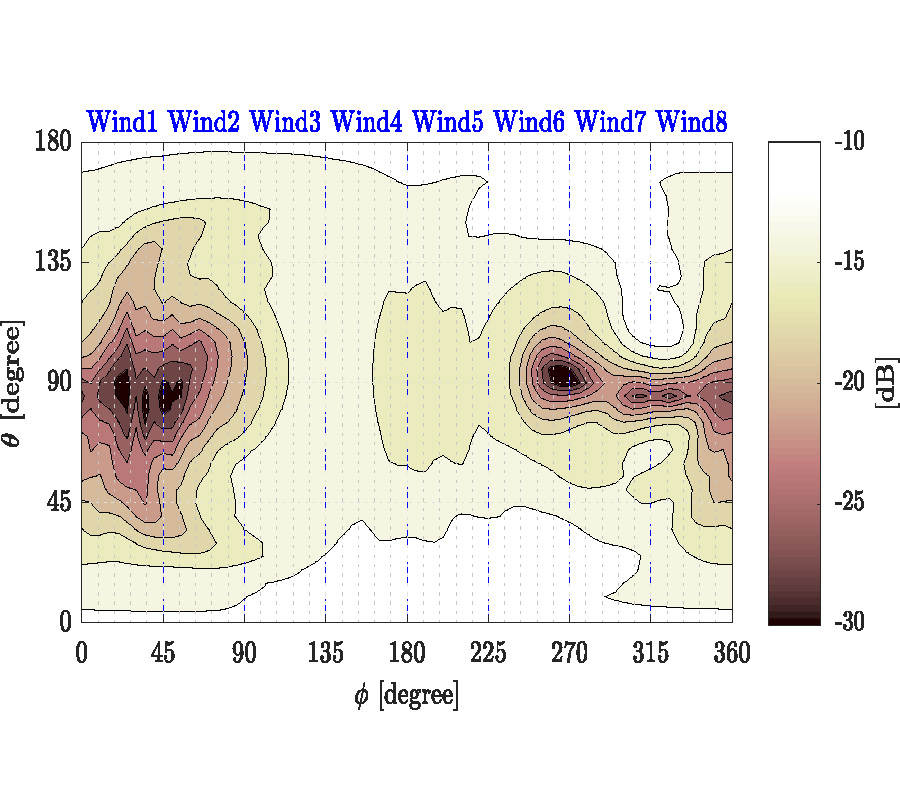
Transient Response of Microstrip Patch Antenna Loaded on a Vehicle Platform Illuminated by Electromagnetic Pulse
Xiao Hu
,
Yang Qiu
,
Qinglin Xu
and
Jin Tian
This paper presents an efficient hybrid method consisting of nonuniform mesh finite-difference-time-domain (FDTD) method, thin wire model, and transmission line (TL) equations method, which is utilized to analyze transient responses of the microstrip patch antenna loaded on a vehicle platform illuminated by a high-power electromagnetic pulse (EMP). This hybrid method avoids over-fine mesh generation, thereby improving the computational efficiency and saving the computational memory. The accuracy and efficiency of this method are verified by comparing with the simulation results of traditional FDTD and computer simulation technology microwave studio (CST MWS). Then, considering the influence of the incident conditions of EMP and the support structure of antenna on the coupling effects of the antenna, the coupling responses of the 1.575 GHz microstrip antenna are discussed in terms of incident angles of EMP, heights of the support structure, top areas of the support structure, and different positions of the support structure on the platform. The obtained changing regularity of the transient responses is useful for further designing the installation structure of the antenna and electromagnetic protection against the external EMP.
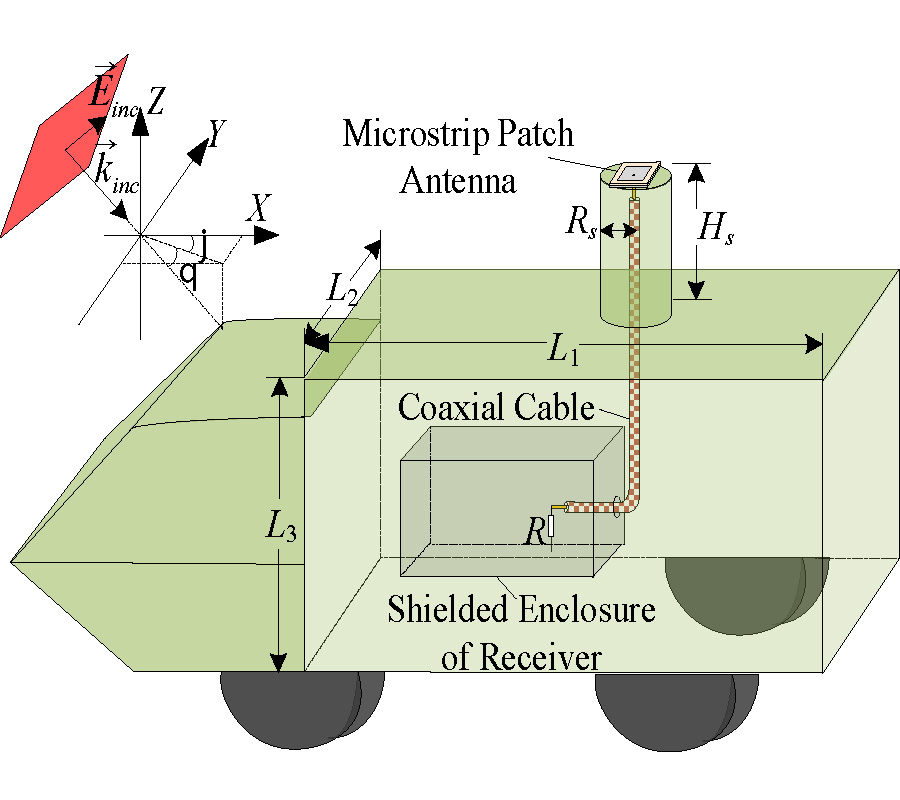
A Compact Quad Port Band-Notched MIMO Antenna for Wi-MAX Applications with Low Mutual Coupling
Bhakti Vinod Nikam
and
Maruti R. Jadhav
High data rates and good channel bandwidth are some of the requirements of today's wireless communication systems. The wireless communication systems are now rapidly adopting a Multiple Input Multiple Output i.e MIMO technique due to its advantages such as the data rates and bandwidth. The main focus of this paper is to design a highly isolated MIMO antenna with Wi-MAX bandwidth. This MIMO antenna design is prepared with four pentagonal slotted monopole antennas with a parasitic element structure operating in the band of 5.1 to 5.8 GHz which offers isolation more than 28 dB. Rectangular slots are used for each radiating patch for a band-notched frequency at 5.5 GHz frequency relative to the Wi-MAX frequency band. To improve the isolation of the antenna, on the surface of the dielectric substrate, a single plus-shaped parasitic structure is uniformly inserted between the antenna elements. The result obtained from the fabricated antenna is at an acceptable range with that of the simulated for the Wi-MAX band applications.
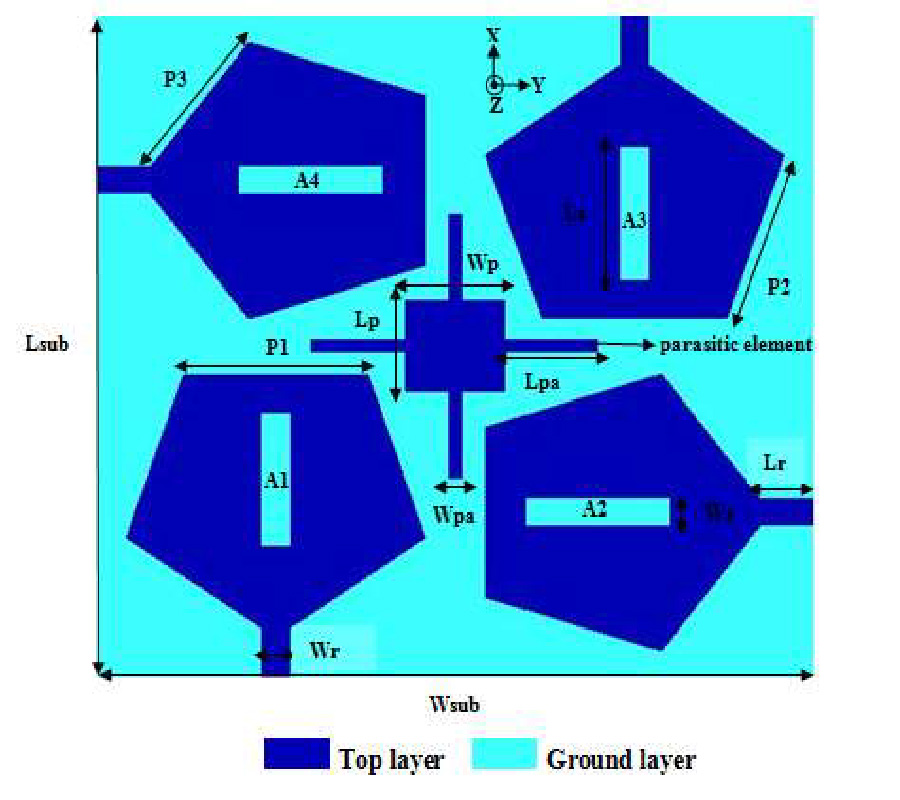
Design of Airborne Radome Using Novel Temperature Dependent Electromagnetic Modeling
Aparna Parameswaran
and
Hrishikesh Sonalikar
In this paper, a novel temperature dependent electromagnetic modeling for the design of airborne radome is presented. A smooth spatial temperature distribution on the radome surface is modeled using a piecewise cubic hermite interpolating polynomial as well as piecewise linear interpolation. The temperature gradient across the radome wall is modeled using the inhomogeneous planar layer. The performance of a radome is computed using the 3D ray tracing method in conjunction with aperture integration. A unique radome wall configuration is obtained for each ray for accurate representation of a hot radome. A streamlined radome designed using the proposed model shows a significant performance improvement over the radome designed at the average temperature. The designed radome has the minimum insertion loss of 0.015 dB and the maximum boresight error of 1.8 mrad. The proposed method can be easily used with the experimentally obtained temperature distribution to predict the changes in radome performance in changing hypersonic environment.

An Improved Calculation Method for Static Capacitance in Inductor Windings
Ming-Xing Du
,
Yuxiao Zhang
,
Hongbin Wang
,
Ye Tian
,
Ziwei Ouyang
and
Ke-Xin Wei
This paper proposes an improved method for calculating static capacitance between two conductors with circular cross-sections in inductor windings. It considers the effects of electric field coupling and energy distribution on static capacitance. In this paper, the capacitance between two conductors in inductor windings is calculated by the improved calculation method and the finite-element method (FEM), respectively. The relative error of the improved calculation method is between 0.11% and 4.51% compared to the FEM. In order to verify the effectiveness of this method for inductor winding, the orthogonal stacking winding and staggered stacking winding are chosen as calculation examples to accurately predict the static capacitance of multi-layer circular-section induction coils. Finite element models for the two types of windings are built to determine the capacitances for our 3×3 array arrangement winding. The results show that the improved calculation method proposed in this paper highly conforms to FEM. Finally, we adopt an air-cored cylindrical inductor winding for experimental verification, and the improved calculation method is proved to be correct.
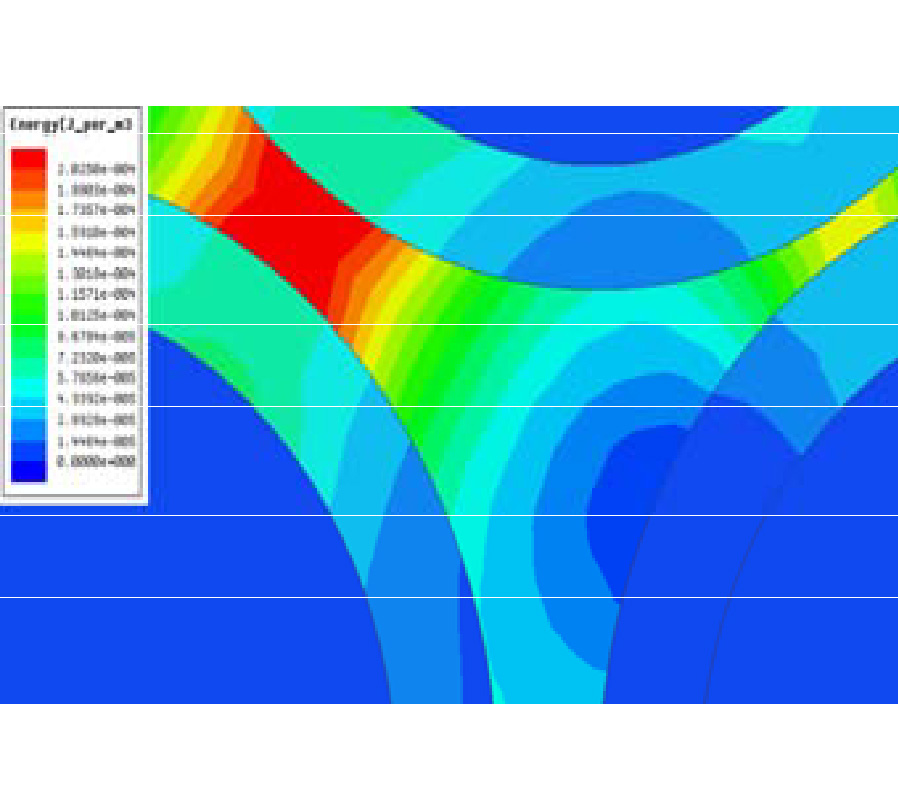
E-Shape Microstrip Antenna for Dual Frequency WLAN Application
Aarti G. Ambekar
and
Amit A. Deshmukh
r exploring the possibility of dual frequency response, a higher order mode frequency response in the air suspended design of a wideband E-shape microstrip antenna is studied, by appropriately decreasing the air gap.The decrease in the air gap realizes the impedance matching at higher order TM12 mode which along with the fundamental TM10 mode,gives dual frequency response. On an air suspended FR4 substrate with total thickness of 0.043λg, optimized single patch configuration yields dual band response at 2427 and 5730 MHz giving frequency ratio of 1:2.36. It yields impedance bandwidths of 6.6 % and 4.8% at two frequencies with respective broadside gains of 6.8 and 2.1dBi. The proposed configuration satisfies the requirements of 2.4/5.8 GHz WLAN applications. Parametric formulations are proposed for various antenna dimensions. The MSAs redesigned using them at given fundamental mode frequency yield a similar dual band response.
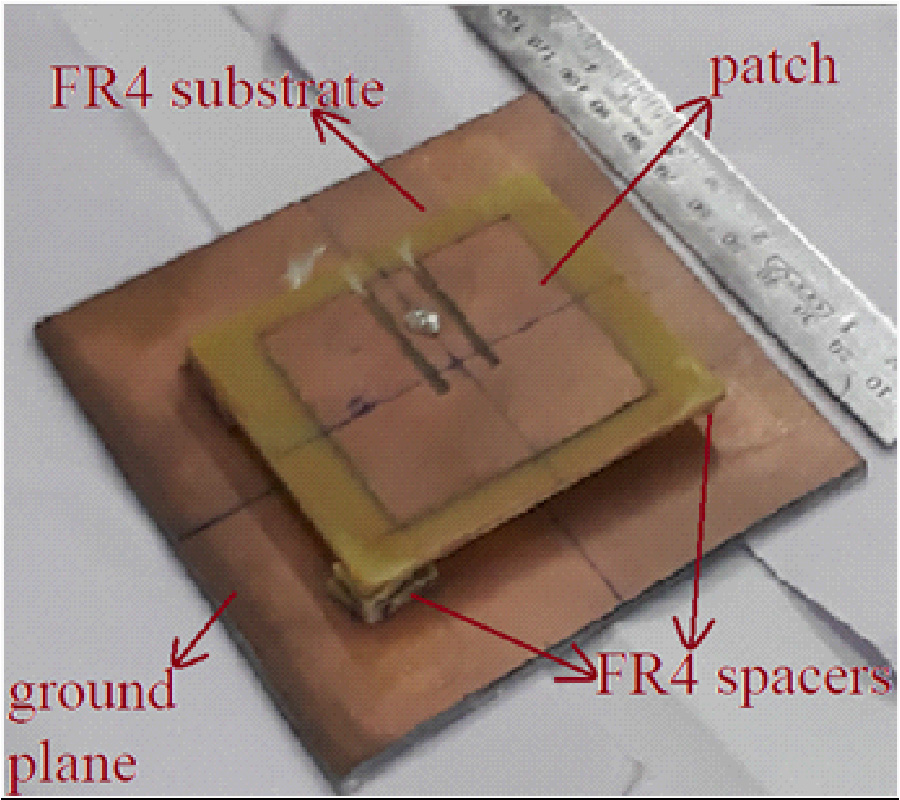
Investigation of Dominant Wave Mechanism and Optimal Antenna Excitation for Body-Centric Wireless Propagations
Daniel Ugochukwu Agu
,
Mary Leece
,
Jose Alcala-Medel
,
Anna Sahdev
,
Jim Lim
,
Matthew Olsen
,
Bithiah Ngan
,
Youngwook Kim
and
Yang Li
Vertically- and horizontally-polarized antennas were investigated for on-body to on-body (OB2OB), in-body to in-body (IB2IB), and on-body to in-body (OB2IB) wireless propagations at frequencies of 915 MHz and 2.45 GHz. Theoretical formulations, simulations, and measurements were employed to study the effect of source antenna orientation on the attenuation of the radio frequency (RF) wave as it propagates around, inside, and through the body near the torso region. The results show that the vertical polarization is preferred for OB2OB communication, and the horizontal polarization is better for IB2IB communication. Furthermore, the dominant propagation mechanism and optimum antenna excitation for OB2IB communication are identified to be distance-dependent. The horizontally-polarized dipole is preferred at a shorter distance while the vertically-polarized dipole is preferred at a larger distance away from the source. The observed results were explained using the estimated attenuation rates of the different propagation mechanisms.
